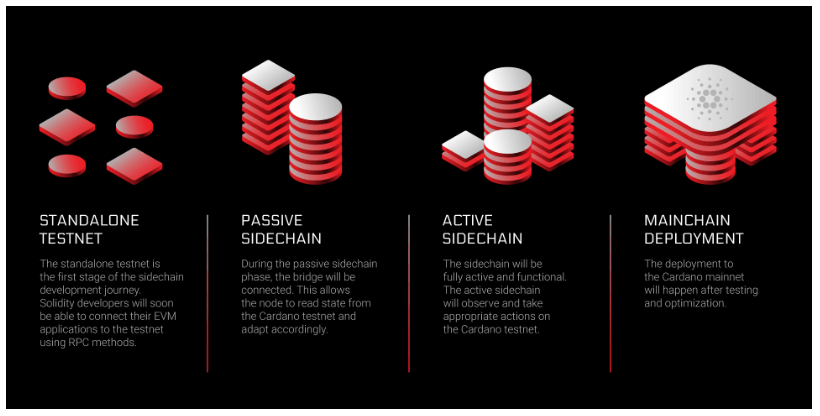On Wednesday (July 6), Olga Hryniuk, who works in the Marketing and Communications department of IO Global (IOG), the blockchain technology firm responsible for the development of Cardano ($ADA), took a closer look at Cardano’s Ethereum Virtual Machine (EVM) sidechain in an IOG blog post written in collaboration with Kathryn Stacy, Technical Product Marketer for IOG Sidechains.
Here is how she explained sidechains in a blog post published on April 28:
“The main benefit of sidechains is their ability to introduce new features to the network without causing security risks to the mainnet. Sidechains expand blockchain’s scalability because they take the burden of processing complex logic off the main chain, thereby increasing the speed (and decreasing the cost) of transaction processing. Sidechains can also act as a two-way mechanism for transferring tokens between the main and additional chains, which in turn greatly increases blockchain interoperability.
“Simply put, a sidechain is a separate blockchain that is connected to the mainnet. The mainnet acts as a parent blockchain, but since sidechains are separate ledgers, they are not affected by the overall traffic. Organizations can set up their own sidechains to process transactions, execute smart contracts, and move tokens faster. These operations are not only more efficient, but also much cheaper than on the main chain, which benefits everyone.
“Sidechains can also inherit some (or all) features of the parent chain, such as the ledger model and consensus mechanism. However, they can also adopt a different model depending on the organization’s goals. For example, a sidechain can combine different security protocols, consensus algorithms, or governance models to create a new sidechain that interoperates with other networks.“
In a blog post published earlier today, Hryniuk started by looking at the benefits that sidechains bring to Cardano, and said that IOG plans to build a whole family of sidechains:
“Over time there is a need for dedicated sidechains that enable a more diverse network of developers to join Cardano, and the tools needed to support the development of applications for specific use cases.
“IOG plans to create a ‘family’ of sidechains that will bring greater scalability, interoperability, and programmability to Cardano. A number of ecosystem contributors are also working on building their own sidechains to add even more capabilities to Cardano.“
She then took a deep dive into the EVM sidechain being built and released by IOG. The reason IOG is doing this is “to allow the Solidity developer community to build DApps on a lower-fees and environmentally friendly platform that consumes far less energy than proof-of-work blockchains.”
Here is how EVM sidechains work:
“Ethereum Virtual Machine (EVM) is a piece of software developed by Ethereum to help computers run smart contracts. Every full Ethereum node runs an instance of the EVM to define how the machine state will change with every new block added to the chain. Sidechains built using the EVM offer features equivalent to the Ethereum blockchain for processing and executing smart contracts. These EVM sidechains are also capable of implementing new features, like a different consensus protocol or ledger model, while still retaining essential EVM scripting capabilities.“
Hryniuk then stated that these are the main four features of IOG’s Cardano EVM sidechain:
- Ethereum compatibility (in particular, this means “hard fork compatibility”, “developer tool compatibility”, “Web3.js wallet compatibility”);
- Ouroboros consensus protocol (Ethereum’s proof-of-work consensus algorithm is replaced with Ouroboros Byzantine Fault Tolerance consensus protocol);
- Permissionless approach;
- Security (various measures — such as the fact “validators and validator candidates are selected from the stake pool operators based on their stake delegation distribution” ensure that the sidechain is secure)
She then provided the following roadmap:

On June 12, IOG tweeted that the alpha version of its EVM sidechain for Cardano had been released on the testnet:
And here is some information from IOG on how how Solidity developers can apply for access to the EVM sidechain alpha release:
Image Credit
Featured Image by ‘EivindPedersen‘ via Pixabay.com









